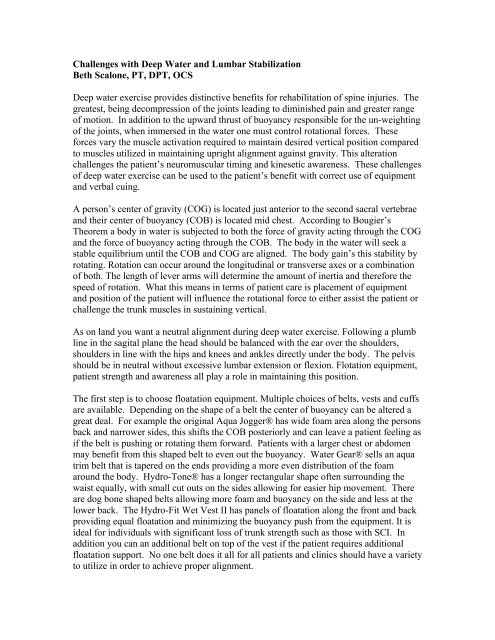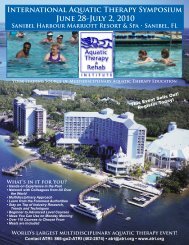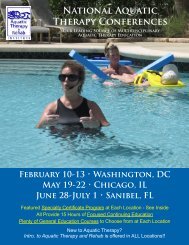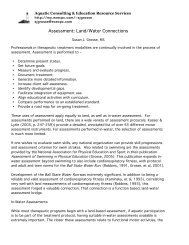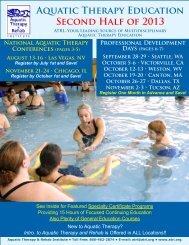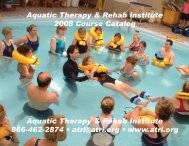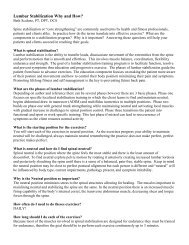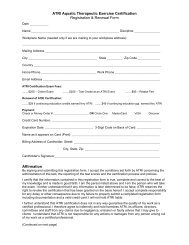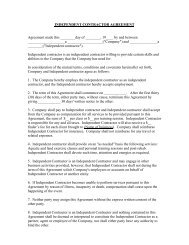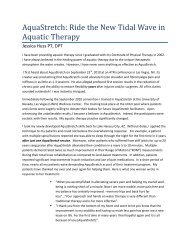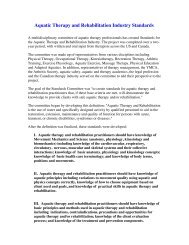Challenges with Deep Water and Lumbar Stabilization Beth Scalone ...
Challenges with Deep Water and Lumbar Stabilization Beth Scalone ...
Challenges with Deep Water and Lumbar Stabilization Beth Scalone ...
- No tags were found...
Create successful ePaper yourself
Turn your PDF publications into a flip-book with our unique Google optimized e-Paper software.
<strong>Challenges</strong> <strong>with</strong> <strong>Deep</strong> <strong>Water</strong> <strong>and</strong> <strong>Lumbar</strong> <strong>Stabilization</strong><strong>Beth</strong> <strong>Scalone</strong>, PT, DPT, OCS<strong>Deep</strong> water exercise provides distinctive benefits for rehabilitation of spine injuries. Thegreatest, being decompression of the joints leading to diminished pain <strong>and</strong> greater rangeof motion. In addition to the upward thrust of buoyancy responsible for the un-weightingof the joints, when immersed in the water one must control rotational forces. Theseforces vary the muscle activation required to maintain desired vertical position comparedto muscles utilized in maintaining upright alignment against gravity. This alterationchallenges the patient’s neuromuscular timing <strong>and</strong> kinesetic awareness. These challengesof deep water exercise can be used to the patient’s benefit <strong>with</strong> correct use of equipment<strong>and</strong> verbal cuing.A person’s center of gravity (COG) is located just anterior to the second sacral vertebrae<strong>and</strong> their center of buoyancy (COB) is located mid chest. According to Bougier’sTheorem a body in water is subjected to both the force of gravity acting through the COG<strong>and</strong> the force of buoyancy acting through the COB. The body in the water will seek astable equilibrium until the COB <strong>and</strong> COG are aligned. The body gain’s this stability byrotating. Rotation can occur around the longitudinal or transverse axes or a combinationof both. The length of lever arms will determine the amount of inertia <strong>and</strong> therefore thespeed of rotation. What this means in terms of patient care is placement of equipment<strong>and</strong> position of the patient will influence the rotational force to either assist the patient orchallenge the trunk muscles in sustaining vertical.As on l<strong>and</strong> you want a neutral alignment during deep water exercise. Following a plumbline in the sagital plane the head should be balanced <strong>with</strong> the ear over the shoulders,shoulders in line <strong>with</strong> the hips <strong>and</strong> knees <strong>and</strong> ankles directly under the body. The pelvisshould be in neutral <strong>with</strong>out excessive lumbar extension or flexion. Flotation equipment,patient strength <strong>and</strong> awareness all play a role in maintaining this position.The first step is to choose floatation equipment. Multiple choices of belts, vests <strong>and</strong> cuffsare available. Depending on the shape of a belt the center of buoyancy can be altered agreat deal. For example the original Aqua Jogger® has wide foam area along the personsback <strong>and</strong> narrower sides, this shifts the COB posteriorly <strong>and</strong> can leave a patient feeling asif the belt is pushing or rotating them forward. Patients <strong>with</strong> a larger chest or abdomenmay benefit from this shaped belt to even out the buoyancy. <strong>Water</strong> Gear® sells an aquatrim belt that is tapered on the ends providing a more even distribution of the foamaround the body. Hydro-Tone® has a longer rectangular shape often surrounding thewaist equally, <strong>with</strong> small cut outs on the sides allowing for easier hip movement. Thereare dog bone shaped belts allowing more foam <strong>and</strong> buoyancy on the side <strong>and</strong> less at thelower back. The Hydro-Fit Wet Vest II has panels of floatation along the front <strong>and</strong> backproviding equal floatation <strong>and</strong> minimizing the buoyancy push from the equipment. It isideal for individuals <strong>with</strong> significant loss of trunk strength such as those <strong>with</strong> SCI. Inaddition you can an additional belt on top of the vest if the patient requires additionalfloatation support. No one belt does it all for all patients <strong>and</strong> clinics should have a varietyto utilize in order to achieve proper alignment.
Additional equipment that can be used for adding flotation <strong>and</strong> increasing the difficultyof an exercise is the buoyancy cuff. Buoyancy cuffs come in different sizes <strong>and</strong> amountsof floatation proving an opportunity for progression. Buoyancy cuffs utilized at theankles provide a great challenge for trunk stabilization in the deep water. By increasingthe buoyancy of the lower limb the trunk <strong>and</strong> hip muscles are more active to maintain theideal vertical alignment. As the patient performs exercises in which the limb movesaway from center the rotational forces are greater. Care should used when adding thecuffs, initiating smaller movements <strong>and</strong> using shorter lever arms when introducing theequipment until the patient demonstrates adequate stabilization <strong>with</strong> the new challenge.Prone <strong>and</strong> supine recovery is especially difficult <strong>with</strong> the cuffs at the ankle. If the feet areat the surface of the water the individual should be instructed to flex the knees towardsthe chest <strong>and</strong> reach arms out in front to assist in return to vertical <strong>and</strong> avoid excessivestrain on the spine muscles.To avoid injury to the shoulder complex adequate floatation is essential. The correctvertical position at rest includes the top of the patient’s shoulder should be out of thewater. This position allows movement of the arms at the surface of the water <strong>with</strong>outexceeding 90 degrees of shoulder flexion <strong>and</strong>/ or abduction. Maintaining shoulderabduction greater than 90 degrees can cause compressive forces at the rotator cuff,placing the shoulder at risk for injury. Shoulder abduction <strong>with</strong> external rotation isrecommended <strong>with</strong> movement greater than 90 degrees.In addition to shoulder injury inadequate flotation can lead to compensatory patterns asthe patient attempts to maintain head out of water position. The most common of thesecompensations includes increased tension through h<strong>and</strong> bars <strong>and</strong> shoulder muscles,breath holding or treading water. The primary problem <strong>with</strong> poor flotation support isinterference <strong>with</strong> desired movement patterns where the patient is working harder to stayabove water <strong>and</strong> not able to concentrate on the exercise.Breathing influences the COB, depending on the amount of air held in the lungs. Cueingthe patient on a specific breathing pattern can assist their movement. Utilizing the exhalefor return to vertical <strong>and</strong> inhale to assist the body toward the surface allows the patient tomove smoothly <strong>and</strong> gain control of movement through the water <strong>with</strong>out excessivereliance on h<strong>and</strong> bars or other equipment. For example the pendulum exercise involvesthe patient to start in a T hang position <strong>with</strong> arms out abducted 90 degrees legs straightdown. The patient swings the feet to the right while reaching left arm to the left <strong>with</strong>outbending at the waist <strong>and</strong> keeping the body in the frontal plane. Having the patient inhaleas they reach to the side <strong>and</strong> exhale as they return to vertical allows the patient to get thefeel of the motion <strong>with</strong>out struggling, twisting or overworking. As strength <strong>and</strong>coordination improves change the breathing pattern to challenge the patient.Cuing is essential in deep water exercise. Proper cuing not only improves exerciseperformance but increases the patient’s perceived value of the training. If one is told tojog in the deep water for 10 minutes <strong>and</strong> does not receive feedback is that patientreceiving skilled therapy? Cues should be positive in nature, avoiding the “don’t do”
phrase, instead provide direct “do” phrases <strong>and</strong> corrections. For example if a patient’sfeet are forward <strong>and</strong> they are flexed at the hips a poor cue would be “don’t bend at yourhips” this comment tells them they are performing the activity wrong but does not givethem feedback on how to improve. A better cue would be” gently contract your buttocksbringing your feet underneath your body <strong>and</strong> your shoulders back”.Because of the altered kinesthetic awareness in the water, early in rehabilitation <strong>and</strong> whennew exercises are introduced frequent <strong>and</strong> varied cues are required to obtain correctposition. Common cues include:– “Relax h<strong>and</strong>s <strong>and</strong> shoulders”– “Gently press heels toward bottom of pool”– “Lengthen the back of your neck/ bring chin in”– “Gently lift chest to bring shoulders back, keeping stomach musclesengaged.”– “Maintain upright spine <strong>with</strong> hips under your shoulders”Although deep water <strong>and</strong> suspended exercise has many advantages not all patients willbenefit. Additional care beyond the st<strong>and</strong>ard aquatic therapy precautions should be taken<strong>with</strong> hydrophobic patients <strong>and</strong> instability. Individuals <strong>with</strong> poor trunk control <strong>and</strong> muscleweakness are at risk for increased shearing forces caused by turbulence; therefore deepwater should be delayed for patients who are early in the post operative phase, after alumbar fusion <strong>and</strong> those who underwent multiple level fusions. Without weight bearingthrough the lower extremities joints <strong>with</strong> ligamentous injury or hypermobility such asindividuals <strong>with</strong> SI joint instability often have a difficult time in deep water <strong>with</strong> lowerextremities in open chain. For these patients shallow water exercise should be utilizeduntil adequate stabilization of the trunk can be maintained.The best way to combat the challenges of deep water is to experience the exercisesyourself, feel how individual belts <strong>and</strong> other equipment alter your position <strong>and</strong> theexercise. Not only does this assist you in choosing equipment it will allow you to bettercue your patients. Once the challenges of deep water exercise are overcome thepossibilities are bottomless.* Please note I am not endorsing the name br<strong>and</strong>s of equipment mentioned, they arecommon br<strong>and</strong>s therefore used for discussion on the differences shape makes in thefloatation belt. There are many options <strong>and</strong> each clinic needs to make purchasingdecisions based on their patient population <strong>and</strong> budget.


